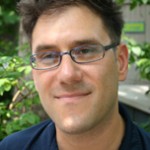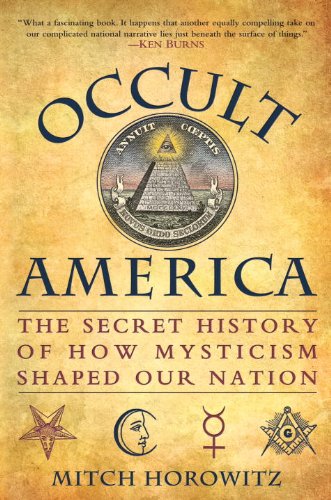We are pleased to welcome Mitch Horowitz as the August 2009 Author of the Month. Mitch Horowitz is the editor-in-chief of Tarcher/Penguin and the author of the Occult America: The Secret History of How Mysticism Shaped Our Nation (Bantam, September 2009), called "a fascinating book" by Ken Burns and "extraordinary" by Deepak Chopra. Horowitz has discussed occult and paranormal ideas on The History Channel, The Montel Williams Show, Air America Radio, Coast to Coast AM, and other popular media. You can visit him online at: www.MitchHorowitz.com. Occult America is available September 8 and can be ordered now online or from your local bookseller. Horowitz is appearing at the Esoteric Quest for Inner America Conference, August 24-28, near Woodstock, New York. For information, please visit: www.esotericquest.org/america/index.html
U.S. Senator James Shields loved a good fight. A former general, he was known to challenge rivals – including future president Abraham Lincoln – to duels. But at the start of a Washington spring day in 1854, Shields startled his Senate colleagues with a gesture that seemed bold, even for him.
On April 17, the Illinois Democrat rose on the Senate floor to speak on behalf of one of the strangest petitions in American history. Signed by a reported 15,000 citizens, the document was, he acknowledged, of a "very singular and novel subject." At this moment his colleagues began to lean forward in their chairs; the hum of conversation on the Senate floor fell silent.
"The petitioners represent," Shields announced, "that certain physical and mental phenomena of a mysterious import have become so prevalent in this country and Europe as to engross a large share of public attention." Citing the neglected work of medieval alchemist Roger Bacon, occult philosopher Cornelius Agrippa, and Hermetic mathematician John Dee, Shields begged his colleagues to take seriously the request of his petitioners to fund a "scientific commission" to study the possibility of talking to the dead – perhaps, Shields offered, even "establishing a spiritual telegraph between the material and spiritual world."
In an era of séances and table-rapping, one senator guffawed that "it would be better to allow the petition to lie on the table." "This is an important subject and should not be sneered away," Shields protested as laughter began to ring from the chamber. Another colleague suggested that the petition be dispatched to the Committee on Foreign Relations. More laughter erupted. Shields, red-faced, agreed to let the proposal drop.
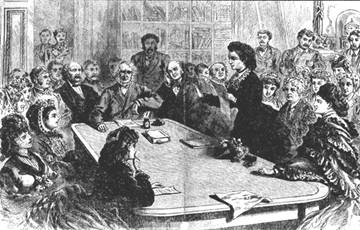
But it was not the last time that Spiritualism had its day in the halls of Congress. In early 1871, the chamber invited the first woman to address a joint congressional committee. That winter day, it was a free-love advocate – and avowed trance medium – named Victoria Woodhull who took the floor (as pictured at left). Poised and handsome, Woodhull delivered a rousing brief in defense of women's suffrage, which she later said had been dictated to her in a dream by a ghostly, tunic-wearing Greek elder-a spirit guardian who had guided all of her public utterances ever since she was a young girl. By the time of Woodhall's appearance, Spiritualism could not be hooted down, even in the Senate. Its acolytes included Mary Todd Lincoln and a range of industrialists, congressmen, and figures from everyday life. The year following Woodhull's speech, suffragists nominated her as the first female candidate for president.
More than a century later, however, the word "occult" seems like a stranger in American life. Today it is tempting to dismiss occultism as no more than the crazy auntie tucked away in the attic of America's history. But that kind of dismissal would be a misreading of occultism's role in America, and of America's role in recent religious history. Indeed, the arcane philosophies grouped under the name of occultism represent an unheralded thought movement in America's national life, one that not only placed horoscopes into nearly every daily newspaper, but that transformed a young nation into the launching pad for the revolutions in alternative spirituality that traveled the globe in the twentieth century.
The Occult Renaissance
Today, the concept of a personal spiritual search, one of self-discovery and experimentation, seems like a birthright. But long before such a notion was generally conceived of, and centuries before America and other nations sought to protect a person's inner search as a right, occult tradition was locked in a struggle to survive.
Early Christendom had characterized pantheists and nature-worshipers, astrologers and cosmologists, cultists and soothsayers, in ways that such believers had never conceived of themselves – as practitioners of black magic and Satan worship. This added a new category of villainy, entirely of the Church's invention, to the Western mindset. Once so characterized, the religious minority could be outlawed and persecuted, just as pagan powers had once done to early Christians.
The Renaissance brought on a surprising reversal. The term "occult" – from the Latin occultus, meaning secret – took on new use through the work of Renaissance-era magus Heinrich Cornelius Agrippa. He used it in 1533 to define his massive study of pre-Christian rites and esoteric lore, De occulta philosophia. Agrippa's overview of occultism – encompassing astrology, alchemy, spirit conjuring, and prophetic or divinatory rituals – reflected the culmination of a series thought currents, some growing directly from church history: Returning Crusaders brought home myths and tales of exotic lands; church reforms began permitting the study of pantheistic Greek and Latin literature; renewed fluency in Hellenic languages led to an unexpected discovery of Egypt's mysterious philosophies; scholars came to realize that monasteries had preserved some of the ancient Hellenic literature during years of Dark Ages' plague and chaos. Feeding one into the other, such developments elevated interest in the allegories, symbols, and magico-scientific ideas of the ancient world.
The proliferation of esoteric philosophies extended into the Elizabethan era and beyond in the work of figures like Giordano Bruno, John Dee, Francis Bacon, and even William Shakespeare, whose Romanesque depictions of gods and myth drew directly on occult Renaissance traditions. But the Elizabethan age also witnessed a backlash, as church partisans began reasserting authority over intellectual life.
In a development that held future significance for America, occult philosophy briefly revived with the advent of a secretive thought movement called Rosicrucianism in the early seventeenth century. Europe marveled at the rumor of an "invisible college" of adepts – master practitioners of hidden wisdom – whose manifestos extolled mysticism and higher learning, while prophesying the dawn of a new age of education and enlightenment. Rosicrucian writings gave powerful expression to ecumenism – a nearly unthinkable ideal at the time and one that likely influenced the religious pluralism of Freemasonry as it later existed in America.
Renewed persecution, however, lay immediately ahead: Church loyalists assailed Rosicrucian ideas. The papal Hapsburg Empire crushed a brief flowering of occult culture in Bohemia when political events tripped the Thirty Years' War. In later generations, the Age of Enlightenment – contrary to the intent of some of its leading intellects – dealt a near-deathblow to occult philosophy. In echoes of the Inquisition, authorities forced astrologers and alchemists, mystics and seers, out of respectable colleges and courts and onto the margins of society, if not underground, to avoid ridicule or persecution.
In the eighteenth century, members of European royalty maintained discrete ties to occult societies and impresarios. But most educated people saw pentagrams, zodiac signs, and mythical images as little more than decorations or guild insignias. And our story of the occult might simply end there – were it not for a young nation across the sea, on whose shores it was just beginning.
An Occult Republic
Even in its colonial history, America was entwined with esoteric spirituality. North America's first intentional mystical community reached its shores in the summer of 1694. That year, the determined spiritual philosopher Johannes Kelpius led about forty pilgrims out of Central Germany – a region decimated by the Thirty Years' War – and to the banks of the Wissahickon Creek, just beyond Philadelphia. The city then hosted only about 500 houses, but it represented a Mecca of freedom for the Kelpius circle, who longed for a new homeland where they could practice their brands of astrology, alchemy, numerology, and mystical Christianity without fear of harassment from church or government.
Soon more mystical thinkers from the Rhine Valley journeyed to America, building a larger commune at Ephrata, Pennsylvania. A young woman named Ann Lee fled persecution in her native Manchester, England and relocated her esoteric sect, the "Shaking Quakers" – or the Shakers – to upstate New York in 1776. That same year, a Rhode Island girl, Jemima Wilkinson, declared herself a spirit channeler, took the name Publick Universal Friend, and began to preach across the northeast. The trend was set: America became a destination for religious idealists, especially those of a supernatural bent.
By the 1830s and 40s, a region of central New York State called "the Burned-Over District" (so-named for its religious passions) became the magnetic center for the religious radicalism sweeping the young nation. Stretching from Albany to Buffalo, it was the Mt. Sinai of American mysticism, giving birth to new religions such as Mormonism and Seventh-Day Adventism, and also to the spread of Spiritualism, Mesmerism, mediumship, table-rapping, séances, and other occult sensations – many of which mirrored, and aided, the rise of Suffragism and related progressive movements. The nation's occult culture gave women their first opportunity to openly serve as religious leaders – in this case as spirit mediums, seers, and channlers. America's social and spiritual radicals were becoming joined, and the partnership would never fade.
The robust growth of occult and mystical movements in nineteenth-century America was aided by the influence of three mighty social and spiritual movements: Freemasonry, Transcendentalism, and Spiritualism. Each helped transform the young nation into a laboratory for religious experiment and a springboard for the revolutions in nontraditional and therapeutic spirituality that eventually swept the globe. Consider:
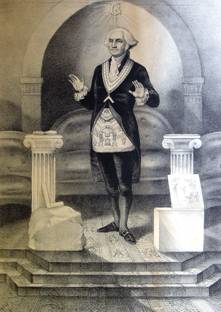
- Freemasonry is, perhaps, a direct remnant of the most radical thought movement to emerge from the Reformation, and it instilled a strong anti-authoritarian streak in America's early religious culture. Masonry's penchant for occult and pagan symbolism suggests how some of the nation's Founders – many of whom were Masons – understood religious truth as emanating from a common source that could be found in different cultures throughout history, including those of a mystical and pre-Christian past. American Masonry emphasized religious tolerance, which its highly placed members, including George Washington (pictured in Masonic garb at left) and Benjamin Franklin, modeled and interwove throughout American life. Early in his presidency, Washington took matters a step further. In a letter to the congregation of a Rhode Island synagogue, the first president wrote: "It is now no more that toleration is spoken of, as if it was by the indulgence of one class of people that another enjoyed the exercise of their inherent national gifts." In other words, minority religions were no longer guests of the new republic, but full members. Whatever Freemasonry's airs of secrecy and images of skulls, pyramids, and all-seeing eyes, it is in this principle where one finds the order's truly most radical, even dangerous, idea: the encouragement of different faiths within a single nation.
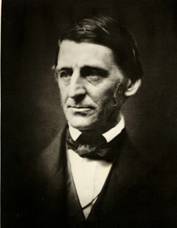
- In New England in the mid-nineteenth century, the writings of Ralph Waldo Emerson, Henry David Thoreau, and their contemporaries extolled the individual's capacity for spiritual self-discovery beyond the boundaries of established religion. Their thought movement called itself Transcendentalism and introduced mystical concepts from Eastern and Western esoteric traditions into the bloodstream of American life. As defined by these "Yankee mystics," Transcendentalism believed the seat of worship – the place of communion with the Divine – existed within. As the Transcendentalists saw it, the individual mirrors a larger cosmos, which bestows a natural order, or ebb and flow of life, and a sense of objective truth. This truth can be verified by lived experience, as it has by seekers throughout history. Transcendentalists drew freely on "Hindoo" texts, such as the Upanishads and Bhagavad Gita, as well as the ethical and religious traditions of antiquity. Echoing the Hermetic concept of As Above, So Below, Emerson depicted man as a microcosm of the universe. ("The world," he wrote, "globes itself in a drop of dew.") Indeed, some saw within Transcendentalism the idea that man shapes the outer world as much as it shapes him. Philosophy, wrote Emerson, "proceeds on the faith that a law determines all phenomena…That law, when in the mind, is an idea." In this sense, Transcendentalism aided the rise of the "positive thinking" and self-improvement movements of the twentieth century.
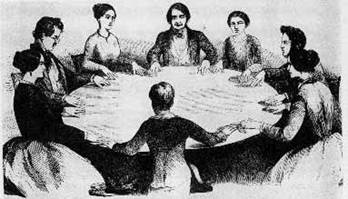
- In the late 1840s, there dawned a movement that popularized belief in the supernatural like nothing the young nation had ever seen. It was called Spiritualism. Through table-rapping, séances, and mediumistic trances, millions of Americans became convinced that communication with the "other side" was available to each individual. Spiritualism also became the first religious movement that Americans exported abroad, inspiring séance circles in London and Paris. Yet the movement had another, largely unknown side. Spiritualism possessed a surprising culture of egalitarianism and social concern. The movement attracted the interest and participation of social reformers because, among other things, it provided a setting in which women – for one of the first times in modern history – could serve as religious leaders, at least of a certain kind. Many spirit mediums were women – active suffragettes among them. Spiritualism's thought leaders, which included the formidable Anglo-American religious thinker Emma Hardinge Britten, saw the movement as the basis of a new religious and social order. Suffragism, free love, talking to the dead, transcendental visions, communal living – each found expression within Spiritualism.
The Theosophical Dawn
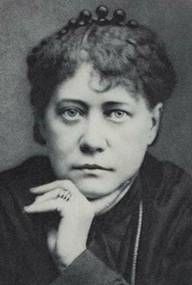
While Spiritualism reached its peak of influence in the United States – and exported its ideas abroad – there appeared in America an occult organization like nothing the West had ever seen. Neither quite Eastern nor Western, it was named the Theosophical Society. Its stated aim was to recover forgotten esoteric ideas at the heart of the world's religious traditions. Theosophy's leading light, a brilliant and eccentric Russian noblewoman named Helena Petrovna Blavatsky, explained that in 1873 she journeyed to America, the land of Spiritualism, "with feelings not unlike those of a Mohammedan approaching the birthplace of his Prophet." The opening created by Spiritualism made the young nation into a magnet for every kind of spiritual experiment.
With retired Civil War colonel Henry Steel Olcott at her side, Madame Blavatsky founded the Theosophical Society in New York City in 1875. Within three years, however, Blavatsky and Olcott departed for India, where their organization grew increasingly active in the early 1880s. At the time, Theosophy dedicated itself to reintroducing Hindu and Buddhist ideas in India and Sri Lanka, whose religious traditions were under twin assault from British colonial rule and missionary campaigns. A core part of Theosophy's mission was to re-ignite interest – in Europe, Asia, and America – in the mystical teachings of the East. The consequences were as enormous as they are today forgotten.
A young, starch-collared law student named Mohandas Gandhi came into contact with Blavatsky's followers when he was studying in London in 1889. In a remarkably overlooked fact of twentieth-century history, Gandhi very openly credited Theosophy with bringing him back to Hinduism, to the study of its holy book, the Bhagavad Gita (which became the guiding text of Gandhi's life), and to the ideals of universal brotherhood. Madame Blavatsky's Key to Theosophy, Gandhi wrote in his autobiography, "stimulated in me the desire to read books on Hinduism, and disabused me of the notion fostered by the missionaries that Hinduism was rife with superstition." Theosophy, Gandhi later told his biographer, "is Hinduism at its best." Hence, it was not in America alone that occultism and social reform crossed paths.
Indeed, the mystical experimentation that had been cut short by the Thirty Years' War seemed everywhere to flourish anew in Europe in the second half of the nineteenth century. On the continent as in America, the theories of Darwin had the dual effect of undermining old ecclesiastical certainties while creating a new hunger for mystery in a biologically ordered world. For avant-garde artists and intellectuals who had lost faith in old-line religion, esoteric philosophies offered a new light. In 1855, French writer-magician Eliphas Lévi, in his Transcendental Magic, proclaimed the existence of an occult philosophy hidden at the base of all "ancient doctrines" and "under the seal of all sacred writings in the ruins of Nineveh or Thebes, on the crumbling stones of old temples and on the blackened visage of the Assyrian or Egyptian sphinx…in the cryptic emblems of our old books on alchemy, in the ceremonies practiced at reception by all secret societies." In Lévi's vision, occultists discovered a renewed sense of mission and drama.
What came to be seen as a European occult revival attracted formidable intellects and earnest seekers, though with a peculiar twist: leading European occultists of the late nineteenth century often adopted airs of secrecy and pageantry, as if mimicking the outer appearances of ancient temple orders and mysterious sects would assist their quest to revive lost or fragmentary knowledge. Often on the thin pretext of concealing hallowed doctrine, they cloaked their study groups and fraternities in mystery and exclusivity. In America, by contrast, occult spirituality was about to make its deepest inroads into the settings of mainstream daily life.
The Power of Mind
By the late nineteenth century, America was suffused with influences from Freemasonry, Transcendentalism, Theosophy, and Spiritualism. Each, in its own fashion, imbued the nation's spiritual culture with the conviction that the Divine existed not at the top rung of a cosmic ladder, but within the settings of ordinary existence.
And ordinary existence was undergoing remarkable changes. As the nineteenth century closed, the fruits of modern science appeared everywhere: telegraphs, motor engines, electricity, and automated production. In medicine, Pasteur's germ theory was explaining illnesses that for years had resisted understanding. In biology, Darwin had theorized a gradual order in the development of all forms of life. In politics, Marx had classified economics as a matter of "science," in which inevitable outcomes could be foreseen. In psychology, Freud had begun to codify childhood traumas that triggered adult neuroses, and hypnotists (more-respectable versions of Mesmerists) claimed the power to alter behavior through autosuggestion and conditioning. Caught in this onrush of currents, intellectual leaders from all walks of life-academia, clergy, business-reasoned that scientific principles were applicable to every aspect of existence. Why couldn't there be a "science" of success, or even a "science" of religion-that is, a protocol of definable, rational steps that would produce a desired result?
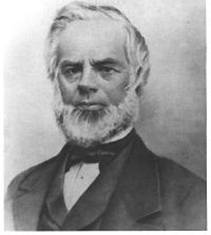
Inspired by the possibilities, a group of religious thinkers and impresarios formed a loosely knit spiritual movement around this "scientific" religious concept. Thoughts, they argued, could be seen to manifest into actual events, such as health or sickness, wealth or poverty. They claimed Ralph Waldo Emerson as their founding prophet: "We know," the Concord mystic wrote in 1841, "that the ancestor of every action is a thought." The Bible, in their reading, seemed to agree, particularly in the Proverb: "As a man thinketh in his heart, so is he." In an enthused leap of reasoning, the movement that came to be known as New Thought maintained that the individual's creative mind was one and the same as the creative force called God. As such, a person could literally think his dreams to life. It was America's boldest-and most influential-attempt at what one religious scholar called "a practical use of the occult powers of the soul."
As thought movements often do, New Thought began with the experience of one individual. A stolid New England clockmaker named Phineas Quimby noticed that his tuberculosis seemed to ease whenever he took a refreshing carriage ride in the Maine countryside. Quimby discovered that as his spirits lifted, so did his illness. Eventually, he was completely cured. Quimby began to study the practice of Mesmerism – in which a subject could be placed into a suggestive trance – and grew fascinated with the health effects of the mind. By 1859, he had devised a philosophy of "mental healing" and began using it to treat the ill. While Quimby focused primarily on the mind's power over disease, he increasingly came to view the subconscious as an extension of the Divine, through which a person could, with the proper training and understanding, construct outer circumstance. His ideas quickly found influence: Quimby treated a patient named Mary Baker Eddy, who went on to establish one of the nation's most significant new religions, Christian Science.
But it was not within any single religion that Quimby's ideas took flight. Indeed, the taciturn Mrs. Eddy (as followers called her) soon denounced her old mentor as little more than a carnival Mesmerist. Nonetheless, his "mental healing" philosophy seemed to ride the winds all across America, winning far-flung adherents and evangelizers who in turn brought their own novel twists to it. It was these inheritors who morphed into the loosely bound psycho-spiritual school known by the late nineteenth century as New Thought. In later decades, this belief system attained mass popularity in the form of Norman Vincent Peale's "power of positive thinking." As such, it reached into nearly every church, living room, and bookstore in America.
Ironically, few Americans today have heard the term or of the movement called New Thought. Its ideas have been so widely adopted that the movement itself – which persists in metaphysical churches throughout America, sometimes under the names of Unity or Religious Science – has become almost unseen. Americans like ideas, but not necessarily movements, which they discard like outer wrapping once an idea has been embraced. Moreover, secularized elements of the New Thought philosophy had already appeared by the last decade of the nineteenth century and successfully vied for influence with the more religiously inspired variants. By the mid-twentieth century, non-religious figures like Dale Carnegie (How to Win Friends and Influence People) and Napoleon Hill (Think and Grow Rich) rode the wings of New Thought to worldwide fame. Today, every life coach, motivational speaker, and self-help program uses the concept of an attitudinal approach to success, of mind over circumstance, and so on. It is easy to forget that this now-familiar concept was very much a mystical philosophy at its birth.
The New Age and Beyond
Amid the material boom of post-War America, the occult seemed sidelined for a time. But by the 1960s, its rumblings were heard again. The early uses of psychedelics appeared to promise the existence of another world just beyond the periphery of our ordinary vision. The concurrent thought revolution brought on by youth culture – with its distrust of staid belief systems – created a resurgence of interest in Eastern spirituality and occultism. By the late 1960s, two factors – the drive toward self-actualization and the acceleration of communication – shook up all aspects of America's religious geography, feeding alternative religious systems from witchcraft to Zen Buddhism to Taoism. In short order, the vast, sprawling term "New Age" entered the popular lexicon, with a meaning malleable to every acolyte and critic.
A core tenet of the New Age was a belief in the fateful convergence of all religious systems, resulting in an era of limitless human potential. Above all, however, the religious opening of the late sixties and early seventies demanded that spiritual teachings be personally useful. The growth in "transpersonal" or meaning-based psychology signaled a bridging of the rupture declared by Freud between the psychological and the religious. Psychology could no longer limit the aims of life to love and work; rather, the questions of purposeful existence had entered the therapist's office – and were there to stay. Likewise, religion was no longer expected to prepare followers for the afterworld, but had to satisfy the flock's needs in the present. First at the margins and increasingly within the mainstream, religion was compelled to address the psychological needs and aspirations of the individual seeker. Even evangelical movements in the early twenty-first century embraced this role. Christian ministers and writers routinely counseled readers and congregants on everything from debt relief to relationship woes to the mental laws of success.
In the public mind, psycho-spiritual philosophies and therapies blended one into another. By the seventies and eighties, there could be no easily discerned "occult" or "Eastern" or "yogic" movement; but rather America experienced the rise of a vast metaphysical culture that appeared ever-expanding, ever-accommodating, and perpetually ready to adapt to any foreign or homegrown influence that met the needs of those who yearned for self-discovery.
Even tough-skinned skeptics who dismissed the New Age as flimflam turned to "woo- woo" methods, often unknowingly. When faced with chronic illness, addiction, or stress, rationalists from every reach of life used alternative approaches in medicine and relaxation-ranging from meditation to hypnotherapy to positive thinking to practices in yoga, herbs, and acupuncture that had entered America through the channel created by arcane subcultures.
The encounter between America and occultism reconciled itself in the creation of a vast spiritual culture that extolled religious egalitarianism and that responded, perhaps more than any other movement in history, to the inner needs and search of the individual. At work and at church, on television and in bookstores, there was no avoiding it: occult America had prevailed.





